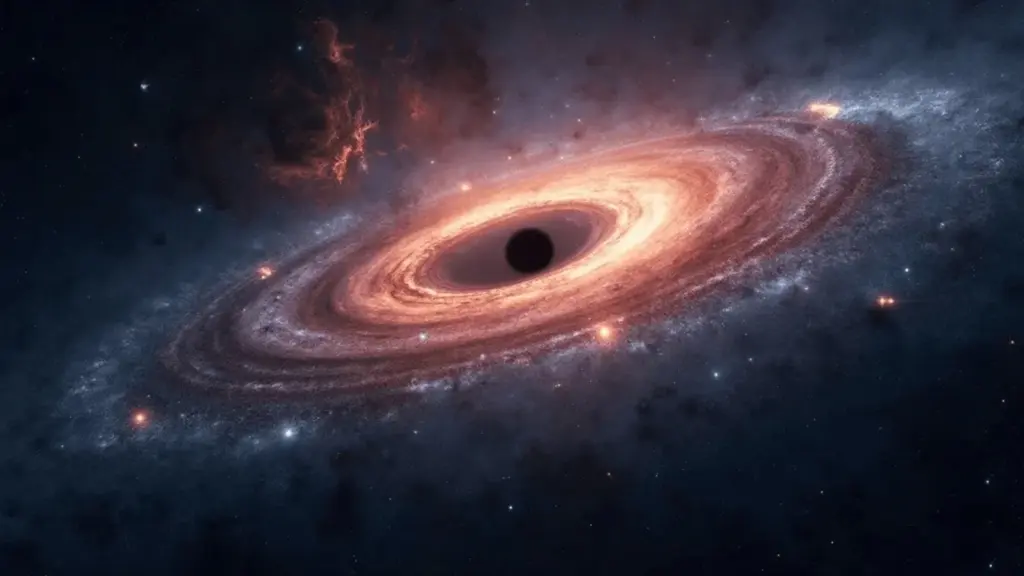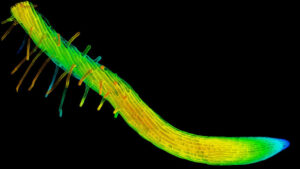
Sagittarius A*, the supermassive black hole at the center of the Milky Way galaxy, has been the focal point of numerous astrophysical studies. Recent advancements in artificial intelligence, coupled with extensive simulations and state-of-the-art computing, have led scientists to uncover groundbreaking insights into this enigmatic cosmic entity. A powerful neural network, trained with millions of synthetic images, has revealed that Sagittarius A* is spinning close to its theoretical maximum speed. This revelation was published in the journal Astronomy & Astrophysics.
The study, spearheaded by an international consortium of astronomers and supported by computational resources at the University of Wisconsin-Madison, marks a significant milestone in black hole research. The findings suggest that the black hole’s axis is oriented nearly in Earth’s direction, challenging previous theories about its orientation and magnetic structure.
Cracking Open Cosmic Mysteries
The Event Horizon Telescope (EHT) captured global attention in 2019 with the first-ever image of a black hole, located in the M87 galaxy. In 2022, it released a new image of Sagittarius A*, the black hole at the heart of our galaxy. However, these images only scratched the surface of what could be learned. The underlying data was rich with signals that scientists were initially unable to interpret fully.
To delve deeper, researchers constructed a library of nearly one million simulated black hole datasets using general relativistic magnetohydrodynamics (GRMHD) simulations. These simulations model how matter behaves under the intense gravitational pull of a black hole. Each synthetic image was paired with variables such as black hole spin, magnetic fields, and disk temperature.
The team employed a Bayesian neural network to analyze these simulations, uncovering patterns hidden within the EHT data. Unlike traditional machine learning models, Bayesian networks estimate uncertainty, providing not just predictions but also a measure of confidence in those predictions.
“That we are defying the prevailing theory is of course exciting,” said lead researcher Michael Janssen from Radboud University in the Netherlands. “However, I see our AI and machine learning approach primarily as a first step. Next, we will improve and extend the associated models and simulations.”
Scaling Science With Supercharged Computing
At the heart of this scientific breakthrough was high-throughput computing (HTC). Unlike supercomputers, which tackle one large task at a time, HTC distributes problems across a vast network of computers, breaking them into thousands of smaller jobs. The Center for High Throughput Computing (CHTC), a collaborative effort by the Morgridge Institute for Research and the University of Wisconsin-Madison, has been refining this approach for decades.
HTC enabled the execution of millions of simulations that would have been impossible with conventional computing. Over three years, the EHT team processed more than 12 million jobs through this system, facilitated by software that automates data handling and scheduling.
“A workload that consists of millions of simulations is a perfect match for our throughput-oriented capabilities,” said Miron Livny, director of CHTC. “We love to collaborate with researchers who challenge the scalability of our services.”
Professor Anthony Gitter, a Morgridge Investigator, added: “We are pleased to see EHT leveraging our throughput computing capabilities to bring the power of AI to their science.”
Rebuilding the Telescope Data From the Ground Up
To ensure the reliability of their results, the researchers also needed to address imperfections in the original EHT data. Enhancements to the data calibration pipeline, including new software and signal stabilization tools, helped reduce noise and improve sensitivity.
The team integrated data from various frequency bands and polarizations, enhancing the clarity of the signals. By synthesizing these data points, they detected more subtle features in the black hole images than ever before.
Each dataset was rigorously compared against the simulations using forward modeling, which predicts what the telescope should observe based on theoretical models. By conducting this process hundreds of thousands of times, researchers could eliminate unrealistic models and focus on those that matched actual observations.
The result was a massive library of synthetic black hole data—932,000 simulated sets for Sagittarius A* and M87*. The simulations captured everything from telescope errors to atmospheric turbulence, creating mock data nearly identical to what the EHT would observe in real life.
A Spin on the Future
One of the most significant revelations from this research is the spin of Sagittarius A*. Black holes can spin at speeds approaching the speed of light, influencing how they accrete matter and emit energy. The new findings suggest that our galaxy’s black hole is spinning at nearly the maximum possible speed.
Furthermore, the study discovered that the bright ring around the black hole, visible in the iconic images, is primarily caused by hot electrons in the accretion disk, rather than jets as previously believed. The magnetic fields surrounding the black hole also appear to behave differently than expected.
These insights were made possible by the neural network’s access to an extensive array of simulated data. Traditional studies relied on only a few dozen synthetic images, whereas this project utilized millions, providing the AI with a vast amount of information to learn from.
“The ability to scale up to the millions of synthetic data files required to train the model is an impressive achievement,” said Chi-kwan Chan from the University of Arizona.
This endeavor necessitated collaboration across various disciplines, with astronomers, computer scientists, and software engineers all playing crucial roles. The goal now is to advance these methods further. Future iterations of the EHT will incorporate more telescopes, higher frequencies, and improved resolution.
As technology progresses, models will become more precise, and AI will be trained on even richer datasets, allowing researchers to unravel even deeper cosmic mysteries. This development underscores the essential role of artificial intelligence and big data in contemporary astronomy. With these tools, researchers are not merely capturing images of black holes—they are beginning to understand them.






